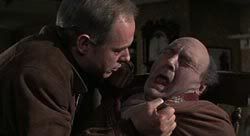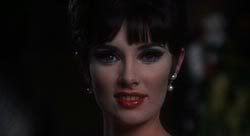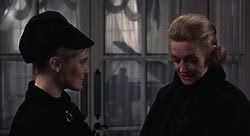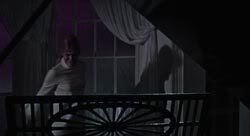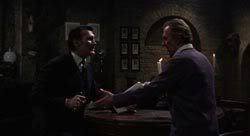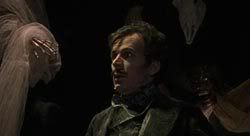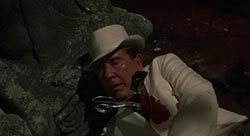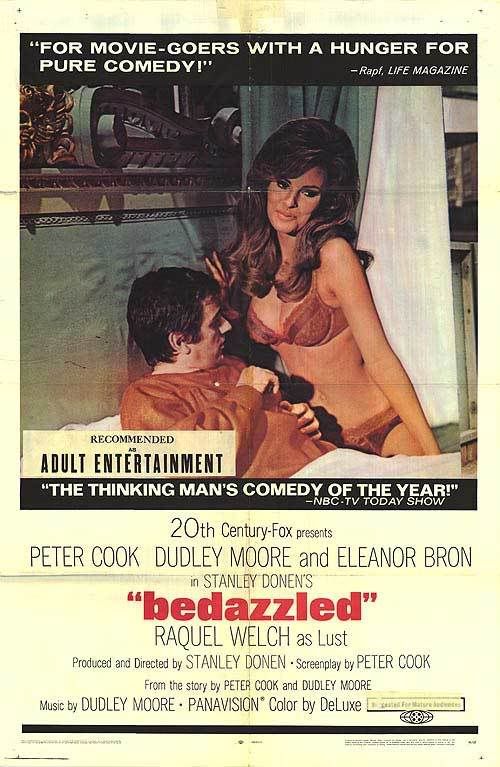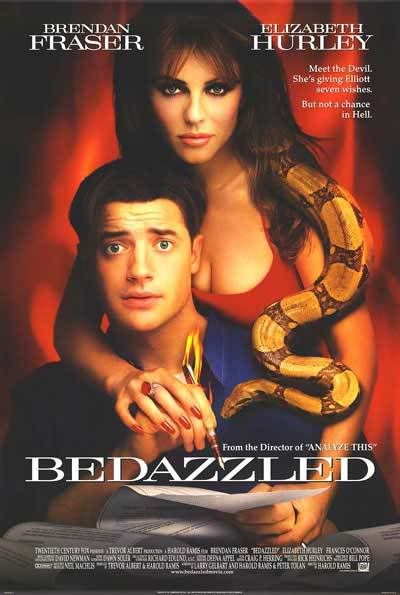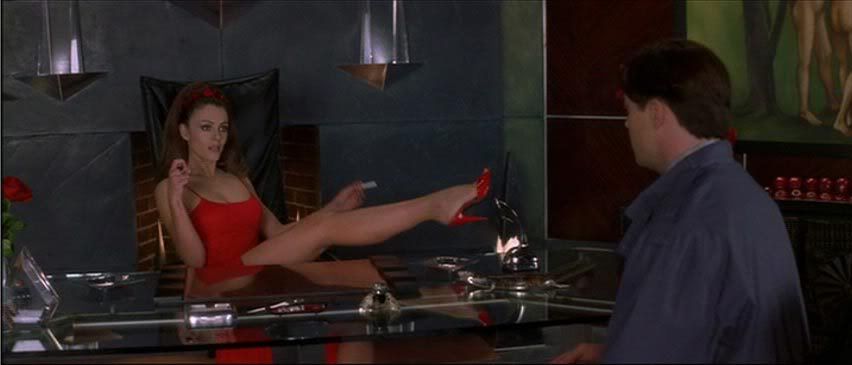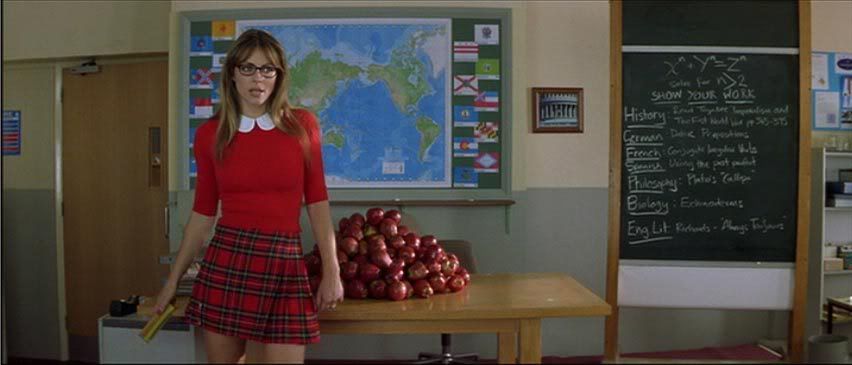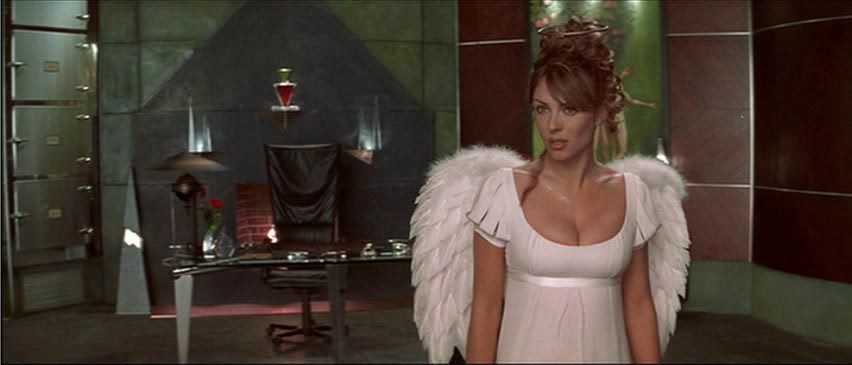Since, at this rate, it appears as though my “October Feature” is going to linger on all the way to Christmas, I’ve decided to step things up and feature four (instead of the three I alluded to in my previous “Why I got distracted” post about my newly-bought toy) of my Ten Favourite Sin-ematic (see, what I did there? Clever, huh?) Devils, bringing my total up to six and leaving me with two weeks to get to the final four. As should be expected this entry isn’t going to be as in-depth (read: self-indulgent) as the first two, but they do say brevity is the soul of wit—a lesson I should have learned years ago.Perhaps today’s the day I finally do!
Included in today’s collection are my pick for the best Devil ever played by an acclaimed film icon, the best Devil ever to appear in a comic book movie stupid fanboys hate despite the fact that it is clearly awesome (and, no, I am not talking about Spawn—even I have enough shame to not go that far), the best Devil ever played by a former Batman villain and, finally, a brief investigation into which counts more—brilliant comic timing coupled with a genius wit or a smoking hot bod (no points for correctly guessing what conclusion I come to).Now, let’s do this thing!Number Eight
Quick quiz! What is the only role that Al Pacino, Robert DeNiro and Jack Nicholson all have on their resumes?
Again, no points for correctly guessing, since you’d have to be something of a dumbass not to figure the answer out considering the subject of this post. I suppose it does say something interesting about our culture that the Lord of All Evil is the only part shared by arguably the three most acclaimed actors of their generation, but I am trying to keep this brief so I’ll avoid that digression and instead just talk about why of the three, DeNiro’s Devil is clearly the best, even if the part does amount to little more than an extended cameo.I am, of course, talking about:
NOTE: MAJOR SPOILAGE
As their careers have progressed, Pacino, DeNiro and Nicholson have all been accused of coasting on their past laurels—giving performances based more on their popular personas from earlier films than providing the audience with characters they have never seen before. All three of them have tarnished their stars a little by accepting parts that were little more than tired pastiches of past roles, clearly for the sake of an easy paycheck, and though they all regularly redeem themselves with great performances in more personal projects, it can sometimes become easy to think that they have descended into the pit of perpetual self-parody.
It’s this sad truth that separates DeNiro’s Devil from those of his peers, as his opportunity to play the part came before this trend took shape and allowed him to give what feels like a real, albeit abbreviated, performance in a powerful and deeply unsettling film. Nicholson, on the other hand, actually began his descent into self-parody with The Witches of Eastwick, in which he—like everyone else in the world—assumed he was so perfectly cast as the Devil, he could simply play himself (or, at least, his onscreen alter ego). And while The Devil’s Advocate is a fun and highly entertaining thriller, there is never a moment in the entire film where Pacino is anything other than Pacino.
DeNiro only appears briefly at the beginning and end of Angel Heart, first showing up as the mysterious Louis Cyphre (say it out loud, you’ll get it), the man who hires P.I. Harry Angel (Mickey Rourke in the best performance of his pre-boxing career) to track down a missing singer named Johnny Favorite. Angel is told that Johnny was injured during WWII and subsequently failed to honour the contract he had signed with Cyphre, who now wants to get what he is owed.
In his search for the singer, Angel finds himself thrust into a dangerous world of black magic and everywhere he turns people end up dead. Only at the end of the film does Cyphre return and reveal to the detective that he need not bothered to have looked so hard.
In just three minutes, DeNiro is able to present us with a Devil more devious and frightening than his two famous counterparts gave us in their entire films and for that alone Louis Cyphre deserves a spot on this list.Number Seven
Next up we have a Devil from one of the best comic book movies no one who reads comic books is supposed to admit liking.I am, of course, talking about:
First things first:FUCK ALAN MOORE!!!
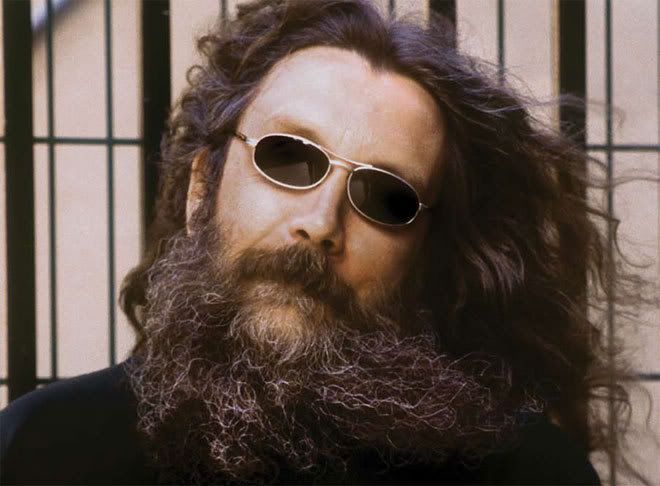
You heard (or—more accurately—read) me. Fuck the bearded twat. What did he do that was so great? Write the most important graphic novel yet written?And….
I kid. Like all other literate comic book enthusiasts, I certainly hold Moore’s work in high regard. I DO NOT, however, subscribe to the popular notion that in the past few years his work has been cynically sodomized by know-nothing Hollywood dumbfucks for the sake of their precious, filthy lucre. On a good day I can even work up the chutzpah to defend League of Extraordinary Gentlemen, an extremely flawed film that I enjoyed nonetheless, so you can imagine how I feel whenever some rabid fanboy starts sniping about legitimately good films such as From Hell and V for Vendetta, out of some ridiculous notion that anything less than 100% fealty to Moore’s original source material represents an artistic sacrilege on par with taking a meat cleaver to Picasso’s Guernica.
For this reason the online reviews that have followed in the wake of the recent release of Constantine on Blu-Ray has provided me with more occasions to gnash my teeth and physically restrain myself from writing extremely ranty emails to their authors. The reason for my distress is that invariably each reviewer will admit that the movie based on a character Moore first made famous in Swamp Thing and who later came into his own in Hellblazer is an extremely well-made and entertaining example of Hollywood filmmaking, but despite this will refuse to give it their whole-hearted recommendation. In each case the clear subtext is “I know what they did to the character (ie. cast a popular and bankable actor) is terrible, but I still kinda, sorta liked it—please forgive me!”
The problem with this is that there was nothing wrong with casting Keanu Reeves as John Constantine, because for all of their extremely vocal lamentations what all fanboys fail to realize is that a film adaptation of anything only ultimately has to be true to itself, not its source material. A single-minded devotion to recreating a work from a different medium without any variation does not guarantee quality. No, Reeves’ John Constantine is not exactly like the comic book’s John Constantine, but that does not negate the fact that Reeve’s Constantine is a very entertaining and compelling character—with or without the English accent, blond hair or nicotine gum at the end. Nor does it negate the fact that the screenplay by Kevin Brodbin and Frank A. Cappello, combined with the visual flourishes of director Francis Lawrence, provided a wholly original cinematic experience that presented to a mainstream audience the kind of dynamic supernatural/religious/detective yarn previously only found in comics like Hellblazer and Sandman.Okay, I’m ranting. I’ll stop now.
Constantine, for those unfamiliar with the film and its source material, is about a paranormal expert/investigator named John Constantine. John does his best to rid the world of its demons—not out of any natural sense of philanthropy, but because he knows—without a doubt—that a teenage suicide attempt has damned him to Hell and the only way he might be able to get out of an eternity of brimstone-scented misery is to get back into the good graces of Heaven. So far, though, his efforts have earned him nothing but the enmity of the Devil, who has promised that Constantine’s soul is the only one he would deign to collect himself. So, in the name of saving his soul Constantine is compelled to help the beautiful Angela Dodson (Rachel Weisz) a police detective whose investigation into her twin sister’s suicide has led her into John’s strange world of demon’s and angels. Together they discover a conspiracy to raise the Antichrist through the use of the infamous Spear of Destiny—the tip of the weapon impaled into Christ’s flesh while he died on the cross. When they discover that the key figure behind all of this is divine rather damned, it appears as though they have no hope of stopping the resurrection. Injured, Constantine realizes that his only possible chance is to see if the Devil (Peter Stormare) is willing to make good on his promise.
But before the Devil can claim his prize, Constantine tells him about the conspiracy to resurrect his son going on in the other room. Not thrilled with the thought of the power struggle this would inevitably lead to, the Devil decides to investigate—slowing time in order for the blade in Gabriel’s (Tilda Swinton, once again cast for her alluring androgyny) hand to miss its target. Confronted by the angel, the Devil is amused to discover that someone else appears to know what’s going on as well.
Having saved his infernal kingdom from war and rebellion, the Devil is gracious enough to provide Constantine with a gift for his information--assuming he will ask for more time on Earth. His is surprised then when John instead asks that the soul of Angela’s sister be sent to Heaven. Confused by John’s generosity, he nonetheless agrees and once the deed is done, grabs his prized soul and begins to drag him towards Hell. Unfortunately for him, it turns out that with this final personal sacrifice, John Constantine has finally gotten Heaven’s attention.
In retrospect I’m somewhat amazed that it actually took me several minutes to realize that the Devil I was seeing onscreen was the same guy who stuck Steve Buscemi in the woodchipper in Fargo (or better yet was the “nihilist” German porn star in The Big Lebowski), since the only other times Peter Stormare has caught me by surprise is when he played a nice guy in Julia Louis Dreyfus' short-lived sitcom Watching Ellie and an astronaut in Armageddon. He’s one of those character actors who always seems out of context playing anything but a total psychopath, so his playing the Devil would seem to be more akin to Nicholsonian typecasting than any kind of stretch. Yet it did take me some time to recognize him largely because his performance is just so darn strange that it’s difficult to think of him as being human, much less the snuff movie creep in 8mm. At turns creepy, frightening, compelling and funny, Stormare truly comes across as a guy who has spent millennia ruling over the most fucked up place in the universe.And you gotta love any movie where the Devil shows up to save the day.Number Six
I’m a huge fan of the British horror movies from the sixties and seventies, which to most folks is a genre synonymous with Hammer Films, the studio responsible for producing most of those pictures. But as much as I love the Hammer movies, I’m actually a bigger fan of the films produced by the much smaller Amicus Productions, largely because most of their best work came in the form of anthology films.
For a small outfit like Amicus the main benefit of making anthology horror films is that they allowed them to hire well-known actors for short periods of time, making their output marketable on a lower budget (it being much cheaper to pay Peter Cushing—who appeared in virtually all of the Amicus anthologies—for three days work than for three weeks). For a viewer the main benefit of watching an anthology horror film is that the format does not allow for much filler. With just 10 to 20 minutes to tell each story, everything but the good stuff pretty much has to be left on the cutting room floor. And if—for whatever reason—a story doesn’t work, you know it’ll soon be over and a potentially better one will take its place.
But the best part about most of these films is watching how the filmmakers chose to connect their stories together. This as much as anything determines how well the film works overall. In From Beyond the Grave, for example, all of the stories are about the fates that befall the customers of a tiny antique shop run by Peter Cushing. In typical EC comics fashion, all of the customers who cheat the (seemingly) doddering proprietor come to horrible ends, while the one honest customer lives to see another day. Less successful is the last of the Amicus anthologies, The Monster Club, which is set in a swinging nightclub populated by various kinds of ghouls and ends up being silly in all of the wrong sorts of ways.
Of all the different wraparounds employed by Amicus, my favourite has to be the one featured in their second anthology.I am, of course, talking about:
Set in a carnival in an unnamed location, the protagonists of the film’s four different stories have all paid admission to enter the midway’s “Torture Garden”, a mini-museum dedicated to man’s inhumanity to man hosted by the devilish Dr. Diablo (Burgess Meredith).
To the five customers who decide to pay to see what’s behind the curtain, the sinister doctor presents an extremely lifelike statue of a woman holding a pair of shears and some thread. He tells them that statue is a representation of fate, with each length of string representing a life and each cut of the shears a death. For the price of their admission each of them will get a chance to see their future fates and how their lives will end.
First up is Colin Williams (Michael Bryant), who is treated to a vision of him murdering his aged uncle in the hopes of uncovering the secret that has allowed the old man to live in his beautiful cottage without ever having to work. Unfortunately for him he quickly discovers the secret buried in the basement—a feline witch’s familiar who can provide great wealth to whoever commands it, but at a terrible price.
Next comes American wannabe starlet, Carla Hayes (Edmonton-born beauty Beverly Adams, best remembered for her role as Dean Martin’s assistant, Lovey Kravezit, in the Matt Helm franchise and for eventually becoming Mrs. Vidal Sassoon), whose burning ambition to become a movie star results in her discovering the hard way the reason why the world’s most famous actors never seem to age.
Following Carla is her British cousin, Dorothy Endicott (Barbara Ewing), a reporter whose romance with a famous piano virtuoso is endangered by the jealous spirit that possesses the instrument he has practiced on his entire life.
Finally it’s Ronald Wyatt’s (Jack Palance) turn to gaze into the shears. In his vision we discover he is an obsessed collector devoted to the life and work of Edger Allen Poe who meets at an auction the one man (Peter Cushing, naturally) whose collection surpasses even his, given that it includes the undead version of the poet/author himself.
After Ronald’s thread is cut only Gordon Roberts (Michael Ripper) remains to have his fate foretold, but after witnessing the reactions of his fellow customers he refuses to take his turn in front of the shears. When Dr. Diablo attempts to force him in front of the statue, the terrified man grabs the shears and plunges them into the doctor’s chest, causing the others to flee the Torture Garden out of terror. It turns out though that Roberts is merely part of the show and the murder is always the closing number. Having figured this out Wyatt reappears and—thanks to his vision—makes it clear that he knows who the doctor really is and that he’s prepared to make a deal with him in the future.
Written by Psycho author, Robert Bloch, Torture Garden is a decidedly hit and miss affair. While none of the four stories stand out as being particularly unique or imaginative, the second and fourth succeed thanks to the actors cast in them. Of the other two, the first is merely mediocre, while the third is undone by the fact that its climax reaches a level of unintended laughable absurdity rather than any kind of terror. More than anything, though, it's Burgess Meredith’s performance as the devilish Dr. Diablo that makes the film so much fun to watch. From the way he starts the film with just a hint of Oswald Copperpot in his performance (note the use of a cigarette holder while he’s in his torturer costume) to his classic delivery of the two words, “It’s murder,” it’s clear the old ham is in his element and having a grand old time.
Of course, as a smart-assed repository of all things trivial, it is my duty to report that this was in fact the second time Meredith played the part of the Lord of Darkness, having starred in the title role in the well-known Twilight Zone episode “Printer’s Devil”, which I would comment on if I had actually seen it.Number Five
And finally we come to the point where I find myself at the crossroads of an aesthetic dilemma. For now I have to make a choice between the two EXTREMELY different actors who played the same role in a 1967 British comedy classic and its much-less admired 2000 Hollywood remake.I am, of course, talking about:
At first glance it might seem to be an easy choice. There’s a reason why the 1967 Stanley Donen directed version of the film is still considered a beloved classic, while the Harold Ramis remake remains largely forgotten less than a decade after its failed theatrical release. Despite a few culture references that haven’t aged well, the first film remains as funny as ever thanks to the delightful chemistry between its two stars, Peter Cook and Dudley Moore—a chemistry never more apparent than in this sequence where George Spiggot aka the Devil (Cook) explains to the lovestruck stooge Stanley Moon (Moore) how he became a fallen angel in the first place:
In the remake, on the other hand, Elizabeth Hurley and Brenden Fraser never share a moment anything close to this in the entire film. While Fraser tries his best with the material he is given, Hurley lacks the comic chops to breathe life into her infernal character and spends the whole film doing nothing more than successfully wearing a series of increasingly alluring outfits.
Like I said, a clear choice, right?WRONG!
You see the problem is that I only came to this conclusion when I started going over the remake to find a good scene to include as evidence of Hurley’s awesomeness. It was only when I seriously studied her work as an actress and ignored how fucking fantastic she looked that I realized she kinda, sorta stank up the screen. For years I considered her Devil superior to Cook’s based solely on the fact that she was so hot it rendered me incapable of judging what she was actually doing onscreen.
That folks takes talent.
I wish I could say that I have as of now reached a firm conclusion on the matter, but trying to decide between a performance that is memorable because of the great comic skill of its performer and one that is memorable because the actress playing the part made it difficult for me to wear pants for a week after I saw the movie is a decision too great for a puny mind like mine to tackle at this moment in time.
Okay, so that’s it for today. Next up we have a look at the classiest of all Devils and the most iconic. Don't be surprised if it's Halloween by the time I get to them.



